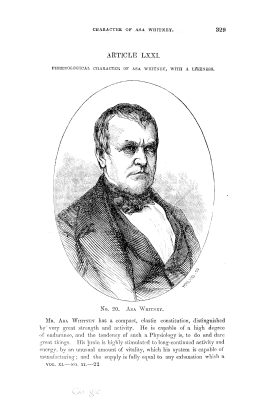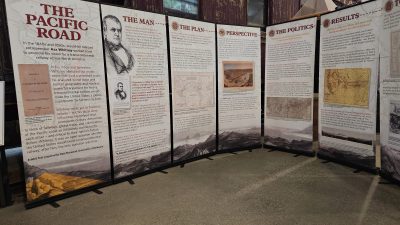
Image of Asa Whitney from “Article LXXI: Phrenological Character of Asa Whitney, with a Likeness,” American Phrenological Journal 11, no. 11 (November 1, 1849): 329.
Our newest exhibit highlights the man who pushed for a transcontinental railroad earlier than most, Asa Whitney. The exhibit text was prepared by Dael Norwood, professor at University of Delaware and the graphic design was done by Mitch Barchi.
This exhibit acknowledges key points about the overall accomplishments and Whitney’s mark on railroad history. First, Asa Whitney was not the only person thinking about transcontinental routes. Connecting Europe and Asia had been a topic of dreams, debate, and planning since the 1600s. He saw the importance of maintaining and supporting trade with Asia. Even today, his predictions were right about trade relations between China and the United States being a large part of both economies. Another fact that made Whitney different was his plan to fund such an enormous task. He decided that he would fund the building himself instead of involving government agencies or political backing. By selling land around the railroad as he went, he could finance the ongoing construction. The most important point in this exhibit is everything that Whitney’s idea would eventually inspire. Although his plan was never used, Whitney’s influences can be seen in the Transcontinental route linking the Central Pacific to the Union Pacific and in even later Union Pacific route maps.
 Spanning eight panels of text and imagery, this exhibit is best suited for the avid historian and the train history buff. Each panel matches a section of the railroad pioneer’s journey from early beginnings, influences, the formation of his plan, his proposal to Congress, the political challenges he faced, the results, and the lasting impact of Whitney’s legacy. The exhibit is on the first aisle of the Train Shed Exhibit Hall next to the Polson Side Dump Car and the Canadian Pacific No. 25.
Spanning eight panels of text and imagery, this exhibit is best suited for the avid historian and the train history buff. Each panel matches a section of the railroad pioneer’s journey from early beginnings, influences, the formation of his plan, his proposal to Congress, the political challenges he faced, the results, and the lasting impact of Whitney’s legacy. The exhibit is on the first aisle of the Train Shed Exhibit Hall next to the Polson Side Dump Car and the Canadian Pacific No. 25.
The Northwest Railway Museum is proud to have an exhibit that highlights such an important early figure in railroad history. The next time you visit the Railway History Campus, please take the time to read through this exhibit. Asa Whitney is a name not many will know but is one that anyone interested in railroad history should remember.

